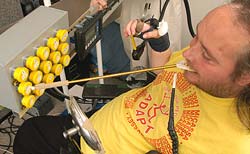Student-Built Pill Dispenser

Williams uses a mouth stick to enter a security code and order medication as needed. <br>Photo by Will Kirk
High-Tech Device Allows Quadriplegic Man to Take Medication Without a Nurse’s Help
Four Johns Hopkins undergraduates have a designed and constructed a computer-guided pill dispensing machine that will enable a quadriplegic man to lead a more independent life. Using a mouth stick, Robert Arthur Williams will be able to order one of up to 12 different medications stored inside the machine. Then, when Williams taps a “slam switch” (he has limited mobility in his right arm), the machine will dispense a pill through a tube leading to Williams’ mouth.
While the students worked on the machine, Williams was able to move out of a nursing home and into a three-bedroom Baltimore area house with two companions who assist with his care. “With this machine, I’ll be able to take medicine for pain or muscle spasms at 3 in the morning without waking up one of my helpers,” he said. “I’ll be able to take care of myself for longer periods of time now.”
Williams, a 40-year-old former welder-mechanic, lost the use of his limbs in 1997 when he was struck by a car while crossing a street. After more than four years in a nursing home on a regimen that required him to take up to a dozen pills a day, Williams sought to live in a more independent setting. “To do that, they told me I’d have to find a way to have my medications dispensed to me whenever I needed them, 24 hours a day,” he said. For help, Williams turned to the Volunteers for Medical Engineering, a Baltimore organization that provides customized equipment and devices to people with unusual medical problems.
VME administrators, in turn, referred the request to students in the Senior Design Project course in the Department of Mechanical Engineering at Johns Hopkins. Four engineering students enrolled in the two-semester course were asked to design, build and test a device that would allow Williams to take his own medication, as needed, despite his severely limited mobility. The students could spend no more than $8,000 to produce their prototype. “This project had so many challenging aspects involved in it — electronics, mechanics, ergonomics and computer programming,” said Ross Whitaker, a member of the student design team. “We got a whole array of engineering experience while working on it.” In the finished device, Williams’ medicine is stored inside a locked box that houses 12 waterwheel shaped dispensers. Each wheel has 15 pill compartments, enabling the device to store up to 180 pills altogether. When Williams needs a particular pill, he can use his mouth stick to press a series of numbered buttons mounted on the front of the unit. First, he enters a security code, then enters the number that corresponds to the medication he wishes to take. Next, when he taps the slam switch, a computer signals the appropriate waterwheel container to turn, dropping the pill into a Teflon coated chute. Gravity causes the pill to slide down the chute and into a flexible tube leading to Williams’ mouth. Water bottles and straws mounted on his wheelchair and near his bed help him swallow the medication. If he needs additional pills, he can repeat the sequence.
“It required a lot of work, but I think the students did a very thorough job on it,” said Alan Markham, a retired engineer and VME member who monitored the project. “The students put a lot of ingenious thought into it.”
“This was a very challenging project, but also a very rewarding one,” said Paul Stemniski, another of the student inventors. “There was a lot of satisfaction in knowing that we were helping Robert.”
Stemniski, 22, a mechanical engineering major from Hockessin, Del., plans to begin graduate engineering studies in the fall at the University of Michigan. Whitaker, 22, a biomedical engineering major from Winslow, Maine, is joining St. Jude Medical Inc. as a field engineer. Their Senior Design Project team also included Mark O’Leary, 21, a mechanical engineering major from Ipswich, Mass., and Yo-Rhin Rhim, 22, a mechanical engineering major from Englewood-Cliffs, N.J. Rhim will enter graduate school at Johns Hopkins in the fall, seeking a master’s degree in mechanical engineering.
The pill dispensing device was one of 11 Johns Hopkins projects completed this year by undergraduates in the Senior Design Project course. The class is taught by Andrew F. Conn, a Johns Hopkins graduate with more than 30 years of experience in public and private research and development. Each team of three or four students, working within budgets of up to $10,000, had to design a device, purchase or fabricate the parts, and assemble the final product. Corporations, government agencies and nonprofit groups provided the assignments and funding. The course is traditionally a well-received hands-on engineering experience for Johns Hopkins undergraduates.
Media Contact
All latest news from the category: Health and Medicine
This subject area encompasses research and studies in the field of human medicine.
Among the wide-ranging list of topics covered here are anesthesiology, anatomy, surgery, human genetics, hygiene and environmental medicine, internal medicine, neurology, pharmacology, physiology, urology and dental medicine.
Newest articles

You are What You Eat—Stanford Study Links Fiber to Anti-Cancer Gene Modulation
The Fiber Gap: A Growing Concern in American Diets Fiber is well known to be an important part of a healthy diet, yet less than 10% of Americans eat the minimum recommended…

Trust Your Gut—RNA-Protein Discovery for Better Immunity
HIRI researchers uncover control mechanisms of polysaccharide utilization in Bacteroides thetaiotaomicron. Researchers at the Helmholtz Institute for RNA-based Infection Research (HIRI) and the Julius-Maximilians-Universität (JMU) in Würzburg have identified a…

ASXL1 Mutation: The Hidden Trigger Behind Blood Cancers and Inflammation
Scientists show how a mutated gene harms red and white blood cells. LA JOLLA, CA—Scientists at La Jolla Institute for Immunology (LJI) have discovered how a mutated gene kicks off…



